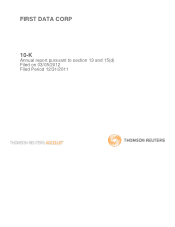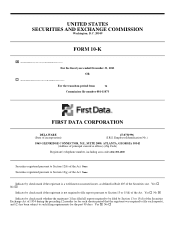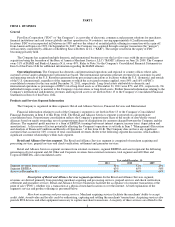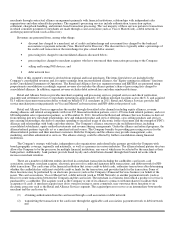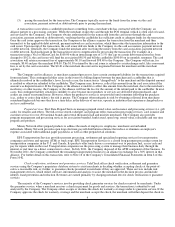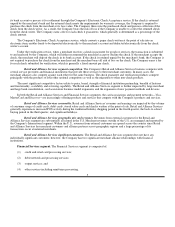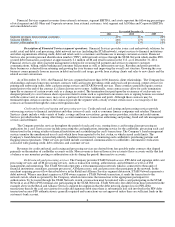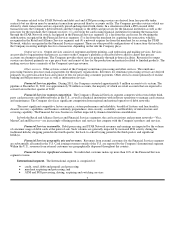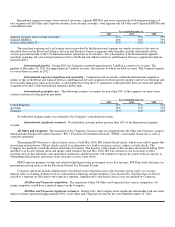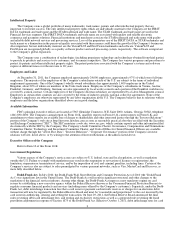First Data 2011 Annual Report Download - page 5
Download and view the complete annual report
Please find page 5 of the 2011 First Data annual report below. You can navigate through the pages in the report by either clicking on the pages listed below, or by using the keyword search tool below to find specific information within the annual report.
merchants through contractual alliance arrangements primarily with financial institutions, relationships with independent sales
organizations and other referral/sales partners. The segment's processing services include authorization, transaction capture,
settlement, chargeback handling, and internet-based transaction processing. The vast majority of these services pertain to transactions
in which consumer payments to merchants are made through a card association (such as Visa or MasterCard), a debit network, or
another payment network (such as Discover).
Revenues are generated from, among other things:
• discount fees charged to a merchant, net of credit card interchange and assessment fees charged by the bankcard
associations or payment networks (Visa, MasterCard or Discover). The discount fee is typically either a percentage of
the credit card transaction or the interchange fee plus a fixed dollar amount;
• processing fees charged to unconsolidated alliances discussed below;
• processing fees charged to merchant acquirers who have outsourced their transaction processing to the Company;
• selling and leasing POS devices; and
• debit network fees.
Most of this segment's revenue is derived from regional and local merchants. The items listed above are included in the
Company's consolidated revenues and, for equity earnings from unconsolidated alliances, the "Equity earnings in affiliates" line item
in the Consolidated Statements of Operations. The Retail and Alliance Services segment revenue and EBITDA are presented using
proportionate consolidation accordingly segment revenue also includes the alliance partner's share of processing fees charged to
consolidated alliances. In addition, segment revenue excludes debit network fees and other reimbursable items.
Retail and Alliance Services provides merchant acquiring and processing services, prepaid services and check verification,
guarantee and settlement services to merchants operating in approximately 4.0 million merchant locations across the U.S. and acquired
$1.5 trillion of payment transaction dollar volume on behalf of U.S. merchants in 2011. Retail and Alliance Services provides full
service merchant processing primarily on Visa and MasterCard transactions and PIN-debit at the point of sale.
Retail and Alliance Services approaches the market through diversified sales channels including equity alliances, revenue
sharing alliances and referral arrangements with over 435 financial institution partners, over 1,170 non-bank referral partners, and over
620 independent sales organization partners, as of December 31, 2011. Growth in the Retail and Alliance Services business is derived
from entering into new merchant relationships, new and enhanced product and service offerings, cross selling products and services
into existing relationships, the shift of consumer spending to increased usage of electronic forms of payment and the strength of FDC's
alliances and relationships with banks and other entities. The Company's alliance structures take on different forms, including
consolidated subsidiaries, equity method investments and revenue sharing arrangements. Under the alliance and referral programs, the
alliance/referral partners typically act as a merchant referral source. The Company benefits by providing processing services for the
alliance/referral partners and their merchant customers. Both the Company and the alliance may provide management, sales,
marketing, and other administrative services. The alliance strategy could be affected by further consolidation among financial
institutions.
The Company's strategy with banks, independent sales organizations and referral/sales partners provides the Company with
broad geographic coverage, regionally and nationally, as well as a presence in various industries. The alliance/referral partner structure
allows the Company to be the processor for multiple financial institutions, any one of which may be selected by the merchant as their
bank partner. Additionally, bank partners provide brand loyalty and a distribution channel through their branch networks which
increases merchant retention.
There are a number of different entities involved in a merchant transaction including the cardholder, card issuer, card
association, merchant, merchant acquirer, electronic processor for credit and signature debit transactions, and debit network for PIN-
debit transactions. The card issuer is the financial institution that issues credit or debit cards, authorizes transactions after determining
whether the cardholder has sufficient available credit or funds for the transaction, and provides funds for the transaction. Some of
these functions may be performed by an electronic processor (such as the Company's Financial Services business) on behalf of the
issuer. The card associations, Visa or MasterCard, a debit network (such as STAR Network) or another payment network (such as
Discover) route transactions between the Company and the card issuer. The merchant is a business from which a product or service is
purchased by a cardholder. The acquirer (such as the Company or one of its alliances) contracts with merchants to facilitate their
acceptance of cards. A merchant acquirer may do its own processing or, more commonly, may outsource those functions to an
electronic processor such as the Retail and Alliance Services segment. The acquirer/processor serves as an intermediary between the
merchant and the card issuer by:
(1) obtaining authorization from the card issuer through a card association or debit network;
(2) transmitting the transaction to the card issuer through the applicable card association, payment network or debit network;
and
3

